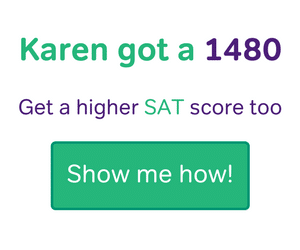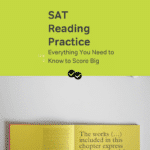The Traps
1. Extreme Language
Often the SAT will make an answer that could debatably be correct by adding a word such as “never”, “always”, or simply, “no”. Remember, the correct answer has to be back up by the text in the answer. But an extreme answer is one that usually doesn’t have text to back it up. The correct answer is usually one that is safer, in the sense that it can be directly supported by a phrase in the passage.
That extreme answers are usually wrong is not some secret information that only I—the SAT guru—know and am sharing to you lucky initiates reading this. “Avoid extreme answers” is advice dished out by almost every SAT expert—so-called and actual. The College Board knows this so they will every now and then throw in a passage in which the author is actually saying something extreme.The most common example is this angry scientist who calls most theories on children and toys are hogwash. Hogwash is an extreme word, but it is in the passage. Therefore, the answer—which regards the author’s tone—is going to be extreme.
So don’t just eliminate an answer because it is extreme. Be on guard, check the passage, and if there is no clear supporting text choose another answer.
2. Perfect answer…except that one part (The Rotten Fruit)
You know how when you buy a fruit or grab one to eat, you turn it around a few times. You are inspecting it for the rotten spot. If you find that spot, you usually toss the fruit aside for some hapless soul, one not so intent on looking for rotten spots, to grab.
With the SAT answer choices, you should never look for those few words that you are not right; you should always look for that rotten spot (even if it is only one word) that is wrong. It only takes one word to make an answer choice wrong, and that word can be hiding in a pile of words, so read carefully.
3. Uses words from around quoted lines
Sometimes you are going to struggle understanding a part of the passage. If a question deals with this part of the passage, you’ll often find yourself going straight for the answers in the hope that they will offer some guidance. Doing so, however, is dangerous—the SAT is waiting for you. It will take words that appear in the very lines being quoted and throw them into an answer. Often that answer choice will say the very opposite of what that passage is saying. But if you are not processing the entire answer choice and just grasping on to those familiar words, you are likely to get trapped.
4. True based on information in the passage
Sometimes an answer choice is wrong because it doesn’t actually answer the question being asked. Sure, you can find supporting text for this wrong answer choice, but since it is not even answering the question it can’t really be the answer.
5. True in the real world
Another tempting wrong answer choice involves an answer choice that just screams pick me! After all, the answer just seems right—right in the way that no one could really disagree with it. And that’s the problem: the answer choice is right in a general sense but is not at all supported by the passage. Again, the lesson is always back up your answer with specific information in the passage.
Below is a short passage (don’t worry I won’t torture you with a 90-liner just to go through the common traps). Your goal is to read the passage and answer the question (duh!), but, more importantly, to categorize the wrong answers based on the five categories above. Once you’ve done this look at my analysis below the passage to see if you are right.
Practice Passage
Cities, the dense agglomerations that dot the globe, have been engines of innovation since Plato and Socrates bickered in an Athenian marketplace. The streets of Florence gave us the Renaissance, and the streets of Birmingham gave us the Industrial Revolution. The great prosperity of contemporary London and Tokyo comes from their ability to introduce new thinking. Wandering these cities—whether down cobblestone sidewalks or grid-cutting cross streets, around roundabouts or under freeways—is to study nothing less than human progress.
The author of the passage would agree with which of the following?
- City governments often limit the flow of ideas.
- Cities have always been centers of innovation.
- Progressive ideas are not generated outside of cities.
- Understanding the history of a city can provide insight into a human process.
- There is no connection between ideas and the financial health of a city.
Solution
Before I get to the correct answer, let’s take a look at each answer choice.
(A) just sounds great. Come on! Think about all those city governments that just aren’t functioning well. Corruption, ineptitude, and, sure, the limited flow of ideas. Sounds like a reasonable thing to say about cities. And, hey, the answer choice is not extreme. It has the word “often”. But wait a second. Does the passage even say that? Doesn’t the passage say that cities like London and Paris are known “to introduce new thinking”? Indeed, (A) is incorrect, but what makes it so tempting is that it sounds like something that is true in the real world: Category #4, from the list above.
(B) There it is, just screaming at you “always.” But is it that obvious? My eyes also see the words “centers of innovation”, which is just so what the passage about. And that’s why extreme language is so dangerous. It’s usually stuffed in their next to some words that are supported by the passage. Based on the text, however, we cannot say that cities—all cities, everywhere, at all times—have been centers of innovation. Category 1.
(C) Just because progressive ideas ARE generated in the city does not mean that they are NOT generated outside of the city. The passage is only saying that cities tend to be centers of innovation. It says nothing about what happens outside the city, so we can’t assume that no progressive ideas come from elsewhere.
(D) is vaguely worded. “A human process”? Geez, talk about vague. But that’s the thing with a right answer choice. It usually isn’t going to take words from the text, in this case “innovation”, “progress”, etc., and just repackage them in the answer choice. Well, actually it will—for a wrong answer choice. For the right answer choice, the SAT tends to reword information from the passage, but in a way that doesn’t just out at you. Here “a human process” equals “innovation”. Also, notice how the answer choice is not worded really strongly, “can provide insight”. And it’s hard to disagree with (D), since the passage is basically saying that learning about cities can help us understand (provide insight) human innovation.
(E) Is pretty flat-out wrong. Notice “financial health” isn’t mentioned at all in the passage. We can call this category 6: not mentioned in passage. Perhaps, more subtly there is the word “no”, which is very strong. And is typically—but not always–used in a wrong answer choice. Since “no” is an example of extreme language, (E) also falls into category #1.
Takeaway
Not every category of wrong answer choices/common traps popped up in our little exercise. I’d recommend trying a medium-length passage (one with around 6-8 questions). Remember, don’t just answer the questions but categorize the wrong answers based on the categories above. You may even notice that a wrong answer choice doesn’t really fit into any of the categories above. Or, in some cases, it may overlap a couple of the categories.






Leave a Reply